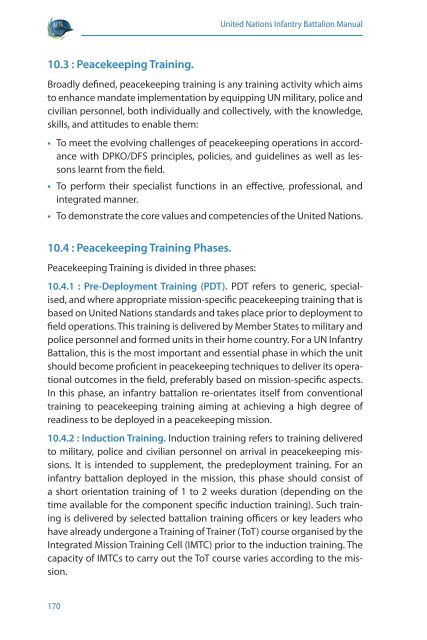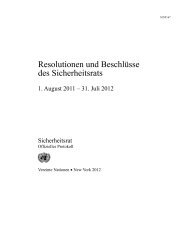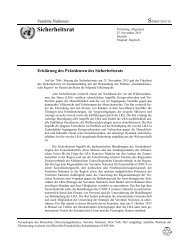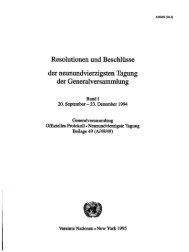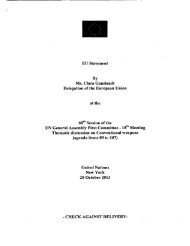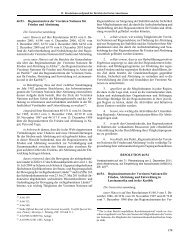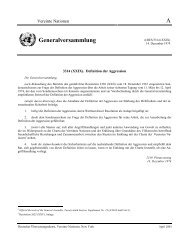United Nations Infantry Battalion Manual - the United Nations
United Nations Infantry Battalion Manual - the United Nations
United Nations Infantry Battalion Manual - the United Nations
Create successful ePaper yourself
Turn your PDF publications into a flip-book with our unique Google optimized e-Paper software.
10.3 : Peacekeeping Training.<br />
170<br />
<strong>United</strong> <strong>Nations</strong> <strong>Infantry</strong> <strong>Battalion</strong> <strong>Manual</strong><br />
Broadly defined, peacekeeping training is any training activity which aims<br />
to enhance mandate implementation by equipping UN military, police and<br />
civilian personnel, both individually and collectively, with <strong>the</strong> knowledge,<br />
skills, and attitudes to enable <strong>the</strong>m:<br />
• To meet <strong>the</strong> evolving challenges of peacekeeping operations in accordance<br />
with DPKO/DFS principles, policies, and guidelines as well as lessons<br />
learnt from <strong>the</strong> field.<br />
• To perform <strong>the</strong>ir specialist functions in an effective, professional, and<br />
integrated manner.<br />
• To demonstrate <strong>the</strong> core values and competencies of <strong>the</strong> <strong>United</strong> <strong>Nations</strong>.<br />
10.4 : Peacekeeping Training Phases.<br />
Peacekeeping Training is divided in three phases:<br />
10.4.1 : Pre-Deployment Training (PDT). PDT refers to generic, specialised,<br />
and where appropriate mission-specific peacekeeping training that is<br />
based on <strong>United</strong> <strong>Nations</strong> stand ards and takes place prior to deployment to<br />
field operations. This training is delivered by Member States to military and<br />
police personnel and formed units in <strong>the</strong>ir home country. For a UN <strong>Infantry</strong><br />
<strong>Battalion</strong>, this is <strong>the</strong> most important and essential phase in which <strong>the</strong> unit<br />
should become proficient in peacekeeping techniques to deliver its operational<br />
outcomes in <strong>the</strong> field, preferably based on mission-specific aspects.<br />
In this phase, an infantry battalion re-orientates itself from conventional<br />
training to peacekeeping training aiming at achieving a high degree of<br />
readiness to be deployed in a peacekeeping mission.<br />
10.4.2 : Induction Training. Induction training refers to training delivered<br />
to military, police and civilian personnel on arrival in peacekeeping missions.<br />
It is intended to supplement, <strong>the</strong> predeployment training. For an<br />
infantry battalion deployed in <strong>the</strong> mission, this phase should consist of<br />
a short orientation training of 1 to 2 weeks duration (depending on <strong>the</strong><br />
time available for <strong>the</strong> component specific induction training). Such training<br />
is delivered by selected battalion training officers or key leaders who<br />
have already undergone a Training of Trainer (ToT) course organised by <strong>the</strong><br />
Integrated Mission Training Cell (IMTC) prior to <strong>the</strong> induction training. The<br />
capacity of IMTCs to carry out <strong>the</strong> ToT course varies according to <strong>the</strong> mission.


